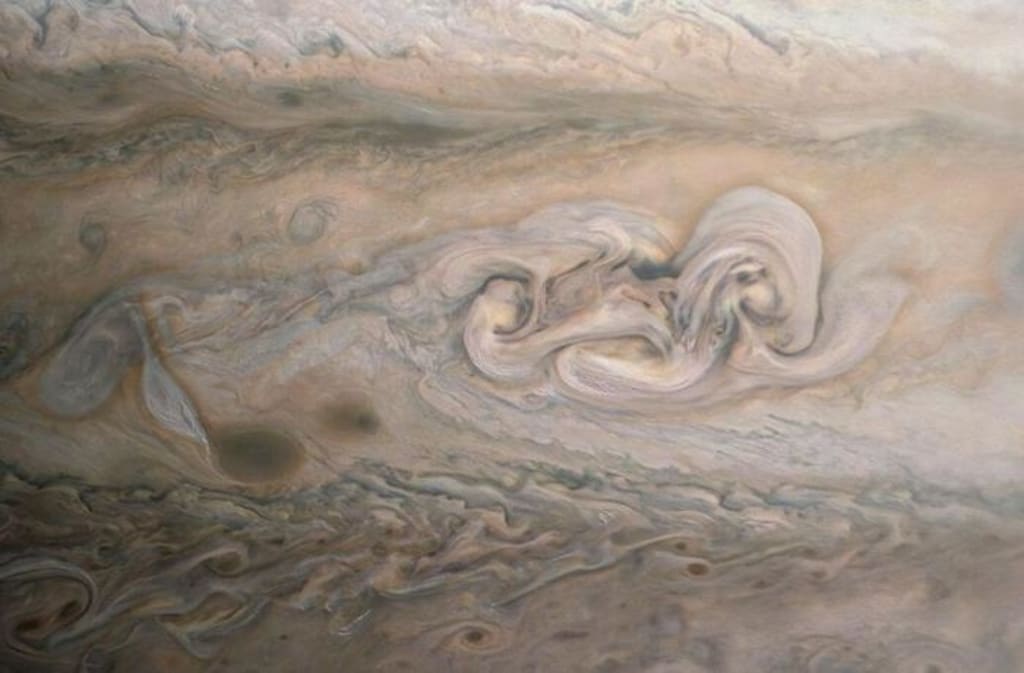Jupiter's "Clyde Spot" Changes, How Magical Are Jupiter's Storms?
How amazing are Jupiter's storms?

NASA's Juno spacecraft imaged a small storm near Jupiter's Red Spot Storm, known as Clay's Spot, in 2020.
Juno's observations of Clay's blob led scientists to believe that the blob here is material ejected from Jupiter's atmosphere. As Juno made many close passes around Jupiter, many of the scenes on Jupiter were captured by Juno. Captured one by one, after a lapse of a year, in 2021, Juno will pass by Jupiter for the 33rd close, and once again photographed Clay's spots.
The spots of Clay photographed this time are completely different from those of a year ago. Clay's spots have gradually disappeared and become a mess of spots.
Jupiter's signature red spots can persist for centuries, but small storms are hard to come by:
In 2020, Juno captured Clay's spot at a distance of 45,000 kilometers from Jupiter's cloud top; in 2021, Juno returned to 27,000 kilometers from Jupiter's cloud top to take another image of Clay's spot.
Through the second shot, scientists found that the oval shape of Clay's spot has been basically chaotic, becoming a swirling spot. The main reason for the change of Clay's spot may be that Clay's spot is gradually moving away from Jupiter's Great Red Spot. .
Since Juno reached Jupiter, it has observed many small Jupiter storms. These storms often appear near Jupiter's Great Red Spot and gradually dissipate when they are far away from the Great Red Spot.
Near the Great Red Spot, small storms are born very quickly, and these storms tend to merge into larger Jupiter storms within a short period of time, forming storms similar to Clay's Spot, and then gradually lose their storm shape as they move away from the Great Red Spot. , which begins to dissipate.
Jupiter's Great Red Spot has been observed for centuries, while Clay's spot has lost its elliptical shape after just a year, according to Juno observations.
Juno has been sending various messages from Jupiter to Earth:
Since Juno arrived at Jupiter in 2016, it has been transmitting photos of the largest planet in the solar system to Earth. In Jupiter's polar regions, Juno has captured special clouds at Jupiter's poles and various storms at the poles.
Through polar observations, Juno discovered Jupiter's polar hexagonal storms for the first time. A series of special storms caused Jupiter to have a very well-proportioned hexagonal airflow. After several airflow simulations, scientists obtained the Jupiter hexagonal Actual results of the storm.
Among Jupiter's many storms, Juno also found a special "reverse storm".
In Jupiter's northern hemisphere, there is a special storm of an anticyclone, which is completely opposite to the direction of the surrounding airflow, forming a maverick "reverse storm".
Juno captured the mysterious storm 7,900 kilometers above Jupiter's cloud tops.
With the gradual completion of Mars exploration, humans will land on Mars for field exploration in the future.
As humans prepare to land on Mars, the next targets for scientists to explore are Jupiter, Saturn and the moons of the two planets. Europa and Titan have been included in the observation process of many astronomers.
The Titan and Europa probes are also under development. I believe that future space exploration will bring us more surprises!
About the Creator
Vicky
The world is so wonderful, let's get to know the world together!
Enjoyed the story? Support the Creator.
Subscribe for free to receive all their stories in your feed. You could also pledge your support or give them a one-off tip, letting them know you appreciate their work.






Comments
There are no comments for this story
Be the first to respond and start the conversation.